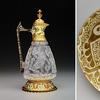Idelle Weber: The Pop Years at Hollis Taggart Galleries
- NEW YORK, New York
- /
- March 28, 2013
Hollis Taggart Galleries is pleased to present an exhibition of acclaimed Pop artist Idelle Weber’s work from the 1960s and ‘70s. Featuring more than 60 examples from the period, the exhibition highlights Weber’s talent as a keen observer of social life, her economic and eloquent use of form and color, and her ability to combine seemingly incompatible elements, such as hand-drawn patterns with manufactured materials.
In her paintings in various media (gouache, tempera, watercolor, acrylic, and oil), collages, and three-dimensional plastic sculptures from this period, Weber depicts figures with her hallmark use of black silhouettes against brightly colored or patterned backgrounds. Munchkins I, II, & III (1964), an imposing triptych spanning seventeen feet, conveys the overwhelming monotony of Organizational Men spied through the transparent facades of their modernist buildings being conveyed to and from their offices like little Munchkins within the world of Oz. In Lever Building 2 (1970), the repetition of frames—like floors in the landmark edifice—emphasizes the alienation and conformity of corporate culture. Weber’s work is especially prescient for drawing out ideas about the ways social roles shape the behavior and dress of men as well as women.
Weber shares with her Pop contemporaries an engagement with the rhetoric of commercial imagery that was then redefining the postwar landscape: she favored hard-edged clarity, bold color, and slick surfaces. Jump Rope Lady (1966) pairs the techniques of outlining and silhouetting with the use of highly saturated, unmodulated areas of color to create a striking composition that vibrates with the sense of stopped motion. Set against moiré or checkerboard patterns, Tiffany blue backgrounds, or iconic cityscapes, such as the Chrysler building’s ornate spire, her art is at once particular and universal, mod and classical.
By asking us to look both at and beyond the surface of corporate and mass culture in the postwar period—its packaging, dress codes, gender roles, and promotion via broadcast media—Weber’s paintings and cut-outs add a unique vision to an iconic movement.
The exhibition is accompanied by a catalogue with an essay by Sid Sachs, the curator of the ground-breaking exhibition Seductive Subversion: Women Pop Artists 1958−1968.
Contact:
Hollis Taggart Galleries212-628-4000
info@hollistaggart.com

100x100_n.jpg)














